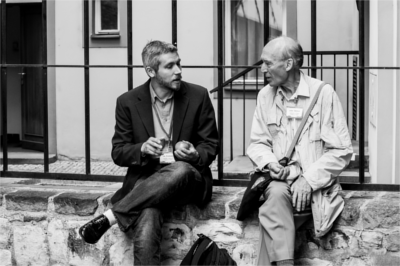UNB researcher presents new theory on time and the universe
Author: Communications
Posted on Nov 17, 2014
Category: UNB Saint John , UNB Fredericton
 A University of New Brunswick researcher has proposed a new theory on the direction of time as scientists move to try to answer such riddles as why do we remember yesterday but not tomorrow?
A University of New Brunswick researcher has proposed a new theory on the direction of time as scientists move to try to answer such riddles as why do we remember yesterday but not tomorrow?
Theoretical physicist Tim Koslowski and colleagues in Ontario and the U.K. are catching a lot of attention for their theory, one that challenges our fundamental understanding of the universe.
In a paper published recently in the journal Physical Review Letters, Koslowski and colleagues examine the so-called “arrow of time.”
Their work is quickly gaining notoriety, attracting notice from otherly scholarly journals such as Physics as well as the mainstream tech publication Wired.
“Many insights in theoretical physics have been the starting point of dramatic changes in worldview. Understanding time could lead to the next big change,” says Koslowski, a post-doctoral fellow at UNB.
They found, for the first time, that the forces of gravity have a bearing on how time flows, and that gravity helps create markers to the past. No such markers of the future are generated – that’s why we don’t form memories of days yet to come.
Koslowski collaborated with Julian Barbour at the University of Oxford and Flavio Mercati of Perimeter Institute for Theoretical Physics in Waterloo, Ont. on this work.
“The problem of the arrow of time has been boggling minds forever,” Mercati told Wired. The commonly accepted theory of the origin of the arrow of time was developed in 1927 by the British astronomer Arthur Eddington. He concluded that the asymmetry of time can be determined by the growth of a measure of disorder, called entropy. This theory assumes that matter always evolves from an ordered state to one of increasing disorder, and that times moves along the path of disorder.
This happens in everyday life. Take, for instance, a shaker half full of salt – all uniform white crystals – and add on top another half filling of pepper. At first, the lower half will be white and the upper half will be black, but the salt and pepper will mix and after some movement the entire shaker will be filled with a salt and pepper mix. The same theory has been applied to the origins of our universe – with time marching in the same direction as the increasing expansion of the cosmos.
The problem with prevailing thinking on the arrow of time is that the universe would have to have been in a highly ordered state to begin with. If that was the case, how did it end up that way?
But this latest theory by Koslowski and colleagues is that it does not require the highly ordered state at the beginning. In fact, they conclude, the effects of gravity reverse Eddington's explanation and pull order out of chaos.
In other words, their work upsets common scientific thinking on both the physics of time and the origins of the universe.
Viqar Husain, a professor of mathematics and statistics at UNB and part of the university’s quantum gravity group, has collaborated with Koslowski on other work.
“Tim’s research tends to be off-the-beaten track. He likes to work on the frontier,” Husain says. “This is work that is being studied around the world.”
Yet, perplexing questions linger.
“When you are looking at the fundamental laws of physics, the laws are exactly the same if time goes forward as it does when it moves backward,” Koslowski says. “So why do we always experience that time is moving forward?”
That’s a question Koslowski hopes to answer – someday.
Media contact: Natasha Ashfield
